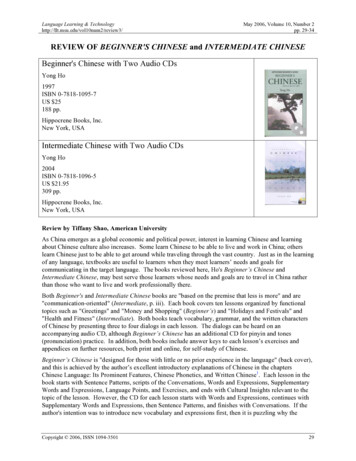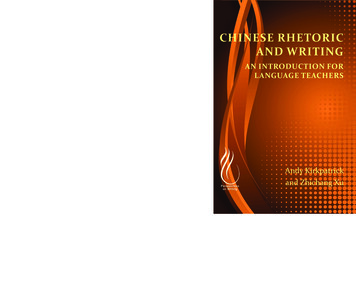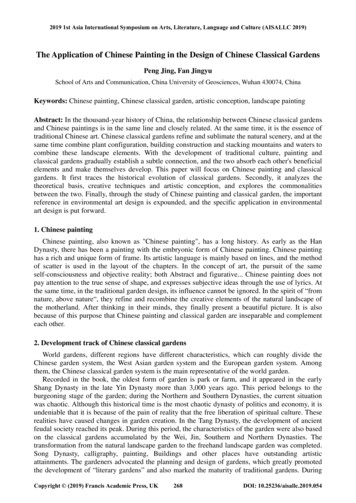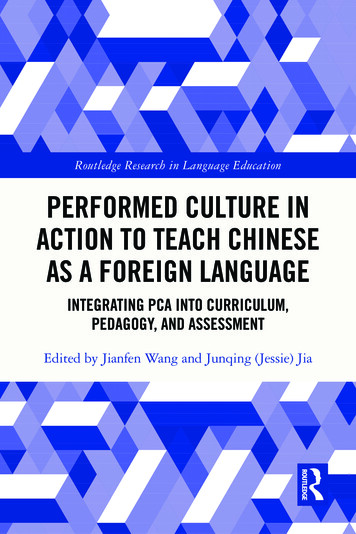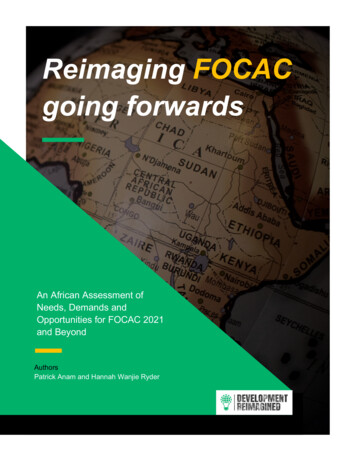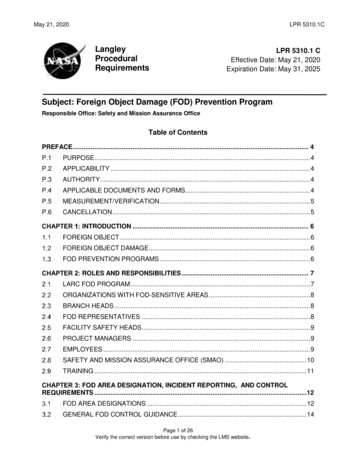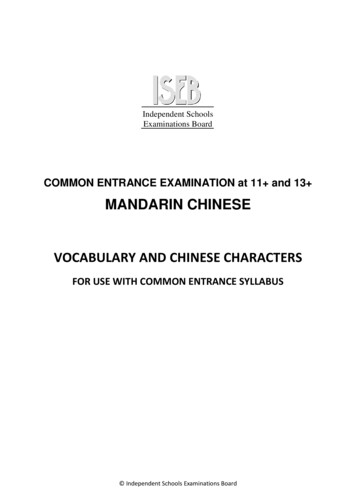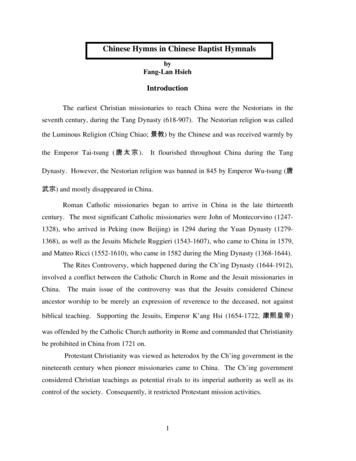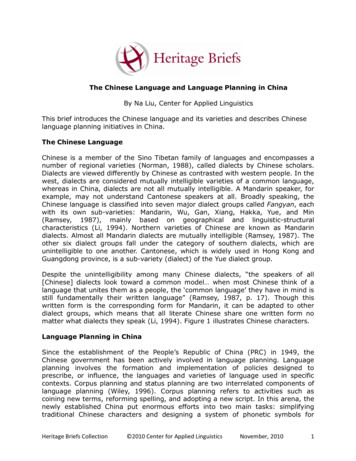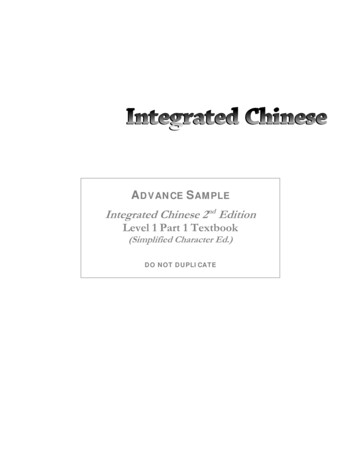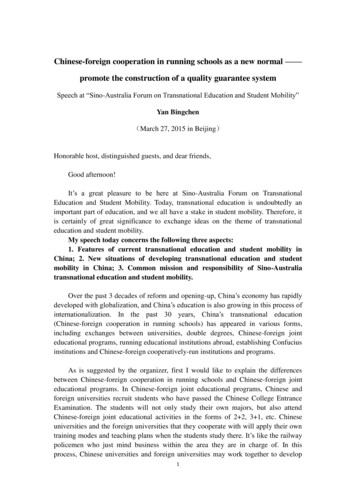
Transcription
Chinese-foreign cooperation in running schools as a new normal ——promote the construction of a quality guarantee systemSpeech at “Sino-Australia Forum on Transnational Education and Student Mobility”Yan Bingchen(March 27, 2015 in Beijing)Honorable host, distinguished guests, and dear friends,Good afternoon!It’s a great pleasure to be here at Sino-Australia Forum on TransnationalEducation and Student Mobility. Today, transnational education is undoubtedly animportant part of education, and we all have a stake in student mobility. Therefore, itis certainly of great significance to exchange ideas on the theme of transnationaleducation and student mobility.My speech today concerns the following three aspects:1. Features of current transnational education and student mobility inChina; 2. New situations of developing transnational education and studentmobility in China; 3. Common mission and responsibility of Sino-Australiatransnational education and student mobility.Over the past 3 decades of reform and opening-up, China’s economy has rapidlydeveloped with globalization, and China’s education is also growing in this process ofinternationalization. In the past 30 years, China’s transnational education(Chinese-foreign cooperation in running schools) has appeared in various forms,including exchanges between universities, double degrees, Chinese-foreign jointeducational programs, running educational institutions abroad, establishing Confuciusinstitutions and Chinese-foreign cooperatively-run institutions and programs.As is suggested by the organizer, first I would like to explain the differencesbetween Chinese-foreign cooperation in running schools and Chinese-foreign jointeducational programs. In Chinese-foreign joint educational programs, Chinese andforeign universities recruit students who have passed the Chinese College EntranceExamination. The students will not only study their own majors, but also attendChinese-foreign joint educational activities in the forms of 2 2, 3 1, etc. Chineseuniversities and the foreign universities that they cooperate with will apply their owntraining modes and teaching plans when the students study there. It’s like the railwaypolicemen who just mind business within the area they are in charge of. In thisprocess, Chinese universities and foreign universities may work together to develop1
some courses, but the joint educational programs does not involve any systematicintroduction of foreign courses and educational resources, and it does not cause anychange in the tuition for the students. By contrast, Chinese-foreign cooperation inrunning schools involves a systemic introduction of educational resources, includingteachers, courses, and cooperation in developing plans of cultivating talents. Thetuition fee is based on the cost of running such schools.1. Features of current transnational education and student mobility inChinaOver the past 3 decades of China’s reform and opening-up, Chinese students goingabroad for study, foreign students coming to China for study, and Chinese-foreigncooperation in running schools have become an important part of China’s educationopening-up to the world. I would like to list 3 sets of data related to Sino-Australiatransnational education. The first is the number of Chinese students going abroad forstudy. Statistics show that 459,800 Chinese students went to over 80 countries forstudy in 2014. The second is the number of foreign students coming to China forstudy, which is 377,000. The third concerns Chinese-foreign cooperation in runningschools. So far, 2324 cooperatively-run educational institutions and programs havebeen officially approved, including 1100 Chinese and foreign universities in 33countries and regions, and the total number of students at study reached 550,000.Australia, UK and America top the list of the countries that cooperate with China inrunning schools. The total number of Chinese students studying abroad, foreignstudents studying in China and those who study in Chinese-foreign cooperatively-runschools amounts to 1.2 million. They are studying in nearly 1,100 universities orcolleges. The statistics indicate that China is now a great power in transnationaleducation.Chinese-foreign cooperation in running schools is closely related to going abroadfor study and it started in the 1980s. In the early stage of Chinese-foreign cooperationin running schools, helping students to go abroad for study is a more importantpurpose than training bilingual teachers and introducing advanced educational ideasfrom abroad. In recent years, there are over 2,000 agreements of Chinese-foreigncooperation in school running. Almost all the agreements include clauses of studyingabroad although the time duration of studying in foreign countries differs.Among the 550,000 students who study in Chinese-foreign cooperatively-runschools, about one-fifth students (around 110,000 students) choose to study abroad. In2014, the total number of Chinese students going abroad for study is 459,800, whichmeans one-fourth students went abroad for study or visiting through Chinese-foreigncooperatively-run institutions or programs. The foreign countries where Chinesestudents choose to study are almost the same ones that cooperate with China inrunning schools. These countries are America, UK, Japan, Korea, Canada andAustralia. In terms of majors, the popular majors in the Chinese-foreigncooperatively-run schools also coincide with the choices of the students who goabroad for study. These majors include management, economics, machine2
manufacturing, engineering, physics and computer science, etc. In terms of structurelevels, 82.4% of the Chinese-foreign cooperatively-run educational institutions orprograms fall into the categories of undergraduate education and higher vocationaleducation. According to the statistics about students studying abroad in 2014, studentswho went abroad for undergraduate education and for graduate education respectivelytake up 30% of the total 459,800 students going abroad. It’s clear that Chinese-foreigncooperatively-run schools connect with going abroad for study on these two levels.There is no doubt that as a form of transnational education, Chinese-foreigncooperation in running schools has become an effective way to make Chinese students’overseas study “safe, healthy and successful”. In turn, overseas study will also serveas a driving force for the Chinese-foreign cooperation in running schools. I believemany of the university teachers present today who are from China and other countriesmay share same views in this aspect.2. New situations of transnational educationAs is known to all, China’s economy is entering a “new normal”. The “newnormal” has the following three characteristics. First, China is experiencing thetransition from high-speed development to medium-speed development. Second, themode of development is changing from extensive growth of expanding scale andquantity to intensive and connotative growth emphasizing quality. Third, the drivingforce of development is shifting from production factors and investment to innovation.When the economy is entering a new normal, new requirements are raised for talentstraining. This will certainly produce new tasks for people involved in education.How can Chinese-foreign cooperation in running schools and overseas study getadjusted to the new conditions of China’s economic development and respond to newsituations?According to statistics, students who come back from overseas study are notoptimistic about the job market. The main reason is that when studying abroad mostof them chose majors such as economic management, computer science and machinemanufacturing, which happen to be covered by Chinese-foreign cooperatively-runschools. In addition, the education quality of Chinese-foreign cooperatively-runschools is getting better and better, so competition is inevitable. From anotherperspective, higher education in China is entering a stage of modernized education.We aim to modernize higher education by 2020 as prescribed in the NationalEducation Plan. That means the quality of talents produced in Chinese universitiesand colleges is improving, which will certainly exert great pressure on overseas studyand Chinese-foreign cooperation in running schools, and will raise new requirementsfor the adjustments of talent cultivation. The economic new normal requires us toadjust and improve the direction of development of cooperatively-run schools andoverseas study.National Education Plan stipulates that the talents we cultivate should haveinternational perspective and good knowledge of international cultures and rules, and3
be skilled at international communication and cooperation. I think this should be animportant goal for the cooperation in running schools and students studying abroad.To achieve this goal, in the past five years Chinese-foreign cooperation in runningschools has entered a new development stage and a new normal, which is featured bythe following 3 elements.First, the development of cooperation in running schools has shifted frompursuing scale expansion to improving quality. At present, there are 7Chinese-foreign cooperatively-run universities in China, including University ofNottingham Ningbo, Xi'an Jiaotong-Liverpool University, New York UniversityShanghai, Kunshan Duke University. They are mostly run by “985 Project”universities in China and world-renowned universities in foreign countries. At thesame time, the connections between these Chinese-foreign cooperatively-runinstitutions are highly valued, so the 7 cooperatively-run universities formed theSino-Foreign Cooperatively-run University Union last year. In addition, the 10cooperatively-run secondary institutions also established Association of Deans. Theestablishment of such professional associations can help achieve self-control, solvethe problems and difficulties in the process of running schools, further improve theeducation quality and take up the mission of cultivating talents throughChinese-foreign cooperation.Second, the driving force for the development of Chinese-foreigncooperation in running schools should be changed from student mobility toimproving the capacity of discipline construction. In recent years, we have higherrequirements for establishing Chinese-foreign cooperatively-run institutions. Werequire systematic introduction of high-quality educational resources from foreignuniversities and Chinese-foreign double certificates in China so that students can getaccess to overseas study without going abroad. However, it does not mean students donot have the chance to go abroad. We stress systematic and overall introduction ofhigh-quality resources and we don’t deny the diversity in the forms of running schools.We have strict criteria for program approval and we must follow the rules of four“one-third”, which means the number of the foreign teachers that are hired, thenumber of the foreign courses that are introduced into China, the number of classesthat foreign teachers teach and others must be 1/3 of the total number respectively.This is a rigid standard that all universities going for cooperatively-run programsshould follow.Third, the Chinese-foreign cooperation in running schools is witnessing achange from fluctuating-speed development to steady-speed development. In thehistory of developing Chinese-foreign cooperation in running schools, we experiencedthe stages of approval pause, review approval and approval banning. But the approvalwork has gone into a new normal since 2010 and we approve programs twice a year.This greatly improves the efficiency of administrative approval and helps maintain theenthusiasm of cooperation between Chinese schools and foreign schools.4
In conclusion, Chinese-foreign cooperation in running schools has thecharacteristics of change in speed, optimization of structure and a change of thedriving force.3. Common mission and responsibility of Sino-Australia transnationaleducation and student mobility.Australia is China’s largest partner in cooperation in running schools. China andAustralia together established 449 cooperatively-run programs and institutions, whichconcern almost all undergraduate and above level universities and some vocationaland technical colleges and educational institutions in Australia. The subjects involvedcover 10 major disciplines. It’s obvious that Sino-Australia cooperation in runningschools has achieved remarkable success and has greatly promoted the cultural andeducational communication and cooperation between the two countries.However, we can still see huge room for improvement in terms of the level ofcooperation. Actually, the American and British universities we cooperate with areworld-famous ones with high ranking on the list of world universities, such as DukeUniversity, New York University, Liverpool University and Nottingham University,etc. Besides, we have many cooperative programs with universities from othercountries that are in the process of approval and application, and they also involvehigh-level universities. By contrast, except for Southeast University and MonashUniversity, we need to improve the level of other Australian educational institutionsthat cooperate with China in running schools. Besides, there exists the problem of oneforeign university cooperating with several Chinese universities in running schools,which is called “Chain stores” by the media. Therefore, how to improve the quality ofSino-Australia cooperation in running schools should be a shared concern.First, we should improve the education quality of the cooperatively-runschools. In November 2013, Chinese Ministry of Education launched its guidance toguarantee the education quality of cooperatively-run schools. It includes the following4 goals: establishing high-level cooperatively-run institutions and programs;optimizing school distribution and planning reasonable structure; establishing aquality guarantee system for China’s transnational education; and improving theeducation quality and management level so that these cooperatively-run schools willeventually serve the local economic development.To achieve the above goals, we can take measures in three aspects.First, we should manage and control the level, the region and the disciplinesof the cooperatively-run schools. We must elevate the threshold for universities withindependent legal entities. The cooperation must be carried out between two famousuniversities. They should set up good examples for others and take up the mission ofChinese-foreign cooperatively-run universities. For those secondary institutes withoutindependent legal entities, we should choose similar fields of disciplines forcooperation. Usually secondary colleges should carry out educational and teachingactivities on one particular subject or discipline. China encourages the Chinese5
universities and foreign universities to exploit more cooperation opportunities inagriculture, forestry, medical science, engineering and leading-edge inter-disciplinaryareas that are in dire need. This adjustment suits the present economic development ofChina. It is fair to say that we have trained enough talents specialized in business orcommercial management. Our next step is to make appropriate adjustments to meetthe needs of the nation and its economic development.Second, we should regulate and manage the process of cooperation by meansof reasonable evaluation. In recent years, we have launched the evaluation forChinese-foreign cooperatively-run schools, which is mainly carried out by ChinaAcademic Degrees & Graduate Education Development Center and China EducationAssociation for International Exchange. We have achieved notable achievements inevaluation over the past years. Three years’ evaluation has made it possible for us toregulate school behaviors, improve education quality and uphold the interests ofstudents. Nearly 100 cooperatively-run programs that fail to meet the standards havequit from the market. In the past, it was a rather daunting task for us to remove theseunqualified programs. Through evaluation and qualification authentication, we hopewe can establish a governance system where management, operation and evaluationare independent of each other, that is to say, society evaluates the qualification,schools run the programs and governments supervise the whole process.Third, we should apply information technology to the management ofcooperatively-run schools. We have developed the online application system, thefiling system, the review system, the evaluation system, the annual report system, andthe registration and authentication system for Chinese-foreign cooperation in runningschools. With the help of these online systems, we are able to set up a one-stop reviewand approval framework, covering all stages from entering, process to exiting. Themanagement of Chinese-foreign cooperation in running schools has basically beeninformatized.Finally, I’d like to put forward two suggestions. In the first place, I hope Chinaand Australia can establish a connectivity mechanism for transnational education orfor the Sino-Australia cooperation in running schools at a senior level. And then, weneed to set up a common quality guarantee system. The biggest problem ofSino-Australia cooperation in running schools is how the students ofcooperatively-run institutions and programs can get a certificate issued by the foreignuniversity within the territory of China. Therefore, we should figure out how toestablish a common quality guarantee system and make the cooperationcertificate-oriented, so as to ensure good quality and maintain the image andreputation of the universities concerned.Thank you!6
cooperatively-run schools connect with going abroad for study on these two levels. There is no doubt that as a form of transnational education, Chinese-foreign cooperation in running schools has become an effective way to make Chinese students' overseas study "safe, healthy and successful". In turn, overseas study will also serve
